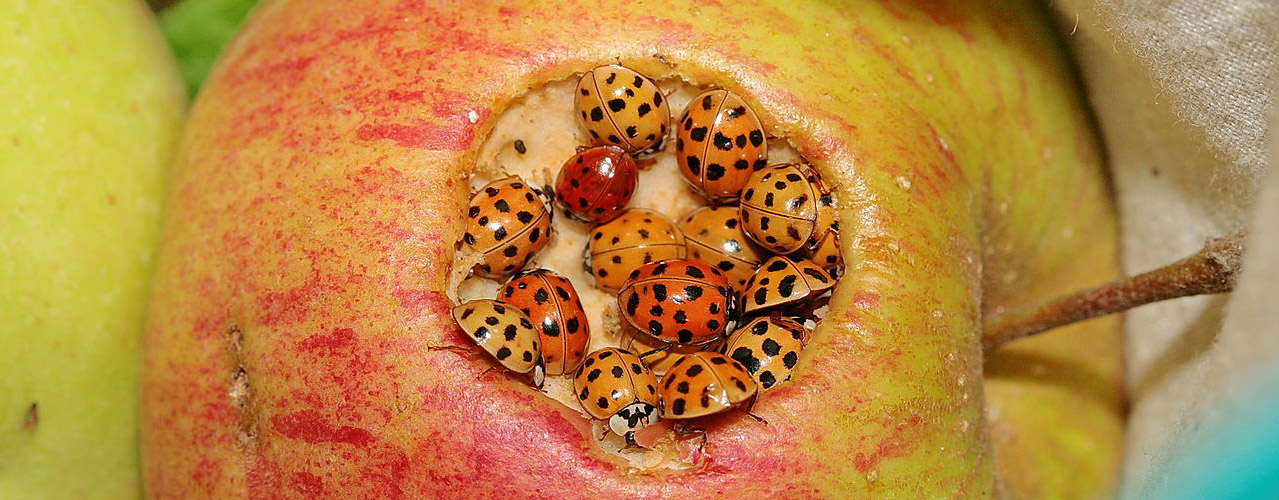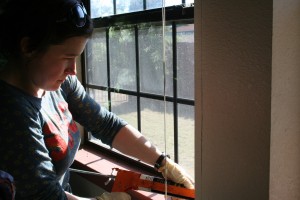Asian lady beetle wears out its century old welcome
As fall progresses, the familiar decorations have come out; colorful gourds and corn, and shocks of cornstalks popping up all over. Oh, yes, and those more-or-less round, orange seasonal accents have again appeared out of nowhere. Of course I mean the tiny orange-y bugs that festoon our walls, window screens and doors, whether or not we want them to decorate that location.

A “drove” of Asian lady beetles making compost of the fruit bowl. Photo: Losch, Creative Commons, some rights reserved
On sunny fall days, the multicolored Asian lady-beetle, Harmonia axyridis, often hangs out with its pals on west or south-facing walls. The insect may be beneficial for gardens and harmless to us, but it amasses in large numbers. I don’t know what the sanctioned collective noun is for a gathering of Harmonia axyridis, but it should be a drove, since they can be enough to drive you out of the house.
From what I can tell, the orange-and-black lady bug, darling of small children everywhere, first arrived in the U.S. (well, we invited them) in 1916 to control aphids on pecan trees and other crops. Adorable lady-beetles didn’t turn into ogres until the mid-1990s. There is evidence to suggest the current population is a strain accidentally released at the Port of New Orleans around 1993. Whatever their origin, Asian lady-beetles are here to stay as an autumn fixture just as sure as potted mums.
Lady bugs don’t carry disease, damage structures, suck blood, bite or sting, and they eat harmful agricultural pests. However, they stain, give off a foul odor when disturbed, and will even pinch one’s skin on occasion. It’s their sheer numbers, though, massing on walls, huddling in corners of garages and porches, coating the insides of picture windows, which unnerves and bugs us.
With cooler weather, these insects will stop swarming and will seek shelter in outbuildings, in wall cavities and other sheltered places. They’ll be out of our hair—figuratively and literally—but will emerge again in spring to find mates.

Caulking windows and other gaps can keep down the lady beetle population and cut your heat bill. Photo: 350.org, Creative Commons, some rights reserved
Managing lady bugs, it turns out, can cut your heating bill. They’re looking for someplace rent-free and warm to spend the winter, and as warm air leaks out here and there from your house, they follow it to its source and let themselves in. Caulk around windows, vents and where cable or other utilities come through the wall, and seal between the foundation and sill. Ensure that door sweeps/ thresholds are tight and check for cracked seals around garage doors. Install screens on attic vents and inspect all window screens.
It’s best to avoid swatting or crushing them because they will release a smelly, staining yellow defense fluid. For a variety of reasons including the lady bugs’ habit of seeking inaccessible areas, indoor pesticide use is of little value, and is strongly discouraged. Instead, use a broom and dustpan to knock them down and then Hoover them up with a vacuum cleaner or shop-vac.

You can vacuum up your surplus lady beetles, just remember to quickly empty it into a pail of soapy water to dispatch them. Photo: Aaron Yoo, Creative Commons, some rights reserved
You can make a reusable “mini-bag” out of a knee-high nylon stocking inserted into the hose of a canister-type vacuum. Secure it on the outside with a rubber band and hang onto it as you clean up the bugs. Just remember to quickly empty it into a pail of soapy water (gas or kero is hazardous and unnecessary).
Next Halloween, maybe try decorating a pumpkin to look like a huge multicolored Asian lady-beetle. On second thought, you’d probably have to spend evenings deterring people from running onto your front porch with shovels, pitchforks and bug spray to try and kill it.
Paul Hetzler is a horticulture and natural resources educator with Cornell Cooperative Extension of St. Lawrence County.
Tags: asian lady beetle, insect pests







